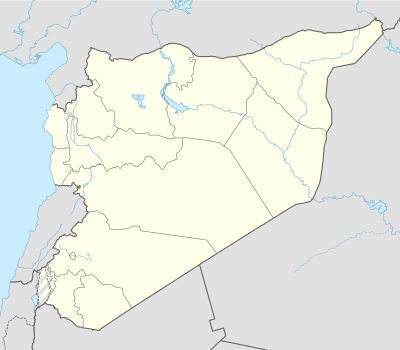The United Nations Educational, Scientific and Cultural Organization (UNESCO) World Heritage Sites are places of importance to cultural or natural heritage as described in the UNESCO World Heritage Convention, established in 1972.[1] The Syrian Arab Republic accepted the convention on 13 August 1975, making its historical sites eligible for inclusion on the list. As of 2016, six sites in Syria are included.[2]
The first site in Syria, Ancient City of Damascus, was inscribed on the list at the 3rd Session of the World Heritage Committee, held in Paris, France in 1979.[3] Ancient City of Bosra and Site of Palmyra were inscribed the following year as the second and the third site, while Ancient City of Aleppo was added in 1986.[4][5] Crac des Chevaliers and Qal'at Salah El-Din were added collectively to the list in 2006, followed by Ancient Villages of Northern Syria in 2011.[6][7]
All six of Syria's properties have been placed on UNESCO's List of World Heritage in Danger since 2013, as their integrity has been to varied degrees compromised following the outbreak of the Syrian Civil War; Aleppo in particular has suffered extensive damage, while a number of prominent structures in Palmyra have been destroyed.[8][9]
World Heritage Sites[edit]
UNESCO lists sites under ten criteria; each entry must meet at least one of the criteria. Criteria i through vi are cultural, and vii through x are natural.[10]
| Site | Image | Location (governorate) | Year listed | UNESCO data | Description |
|---|---|---|---|---|---|
| Ancient City of Aleppo |
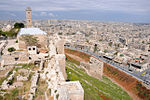
|
Aleppo | 1986 | Cultural: (iii)(iv) |
Situated at the crossroads of several trade routes, Aleppo has been successively ruled, among others, by the Romans, Ayyubids, Mameluks and Ottomans, each leaving significant influence in its architectural fabric, resulting in a diverse cityscape. Major structures include the Citadel, the Great Mosque and the Madrasa Halawiye.[11] |
| Ancient City of Bosra |

|
Daraa | 1980 | Cultural: (i)(iii)(vi) |
Formerly a Nabataean settlement, Bosra was conquered by the Romans in the 2nd century CE and made capital of Arabia. It came under Islamic rule in the 7th century. Remains of the ancient city include a theatre, a basilica, a cathedral, a mosque and a madrasa, among others.[12] |
| Ancient City of Damascus |
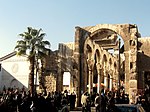
|
Damascus | 1979 | Cultural: (i)(ii)(iii)(iv)(vi) |
Established the 3rd millennium BCE, Damascus is considered to be one of the oldest continuously inhabited cities in the world. As the capital of the Umayyads, it has been of significant influence to the Arab world. The Great Mosque is among the largest in the world and the oldest sites of continuous prayer since the beginnings of Islam.[13] |
| Ancient Villages of Northern Syria |
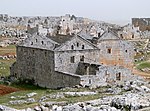
|
several sites | 2011 | Cultural: (iii)(iv)(v) |
The site comprises some 40 villages, dating from the 1st to 7th centuries and abandoned in the 8th to 10th centuries. They provide an insight into rural life in Late Antiquity and during the Byzantine period.[14] |
| Crac des Chevaliers and Qal'at Salah El-Din |
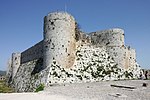
|
Homs, Latakia | 2006 | Cultural: (ii)(iv) |
The Crac des Chevaliers and the Qal'at Salah El-Din are regarded as two of the most prominent examples of castles during the Crusader period, demonstrating an evolution of fortifications and exchange of influences in defensive technology.[15] |
| Site of Palmyra |

|
Homs | 1980 | Cultural: (i)(ii)(iv) |
Palmyra came under Roman rule in the 1st century CE, and grew to become one of the most important cultural centres of the ancient world. Its extensive ruins include remains of the Great Colonnade, the Temple of Bel, the Camp of Diocletian and the Roman Theatre.[16] |
Tentative list[edit]
In addition to sites inscribed on the World Heritage List, member states can maintain a list of tentative sites that they may consider for nomination. Nominations for the World Heritage List are only accepted if the site was previously listed on the tentative list.[17] As of 2016, Syria lists twelve properties on its tentative list:[18]
- Norias of Hama
- Ugarit (Tell Shamra)
- Ebla (Tell Mardikh)
- Mari (Tell Hariri)
- Dura-Europos
- Apamea (Afamia)
- Desert Castle: Qasr al-Hayr al-Sharqi
- Ma'loula
- Tartus: The City-fortress of the Crusaders
- Raqqa-Rafiqah: The Abbasid City
- Island of Arwad
- Mari & Dura-Europos: Sites of Euphrates Valley
Location of inscribed sites[edit]
See also[edit]
References[edit]
- ^ "The World Heritage Convention". UNESCO. Retrieved 21 September 2010.
- ^ "Syria". UNESCO. Retrieved 9 August 2016.
- ^ "Report of the 3rd Session of the Committee". UNESCO. Retrieved 9 August 2016.
- ^ "Report of the 4th Session of the Committee". UNESCO. Retrieved 9 August 2016.
- ^ "Report of the 10th Session of the Committee". UNESCO. Retrieved 9 August 2016.
- ^ "Decision: 30 COM 8B.38". UNESCO. Retrieved 9 August 2016.
- ^ "Decision: 35 COM 8B.23". UNESCO. Retrieved 9 August 2016.
- ^ "State of Conservation (SOC 2013) Ancient City of Aleppo (Syrian Arab Republic)". UNESCO. Retrieved 9 August 2016.
- ^ "State of Conservation (SOC 2016) Site of Palmyra (Syrian Arab Republic)". UNESCO. Retrieved 9 August 2016.
- ^ "UNESCO World Heritage Centre – The Criteria for Selection". UNESCO World Heritage Centre. Archived from the original on 12 June 2016. Retrieved 17 August 2018.
- ^ "Ancient City of Aleppo". UNESCO. Retrieved 17 August 2011.
- ^ "Ancient City of Bosra". UNESCO. Retrieved 17 August 2011.
- ^ "Ancient City of Damascus". UNESCO. Retrieved 17 August 2011.
- ^ "Ancient Villages of Northern Syria". UNESCO. Retrieved 17 August 2011.
- ^ "Crac des Chevaliers and Qal'at Salah El-Din". UNESCO. Retrieved 17 August 2011.
- ^ "Site of Palmyra". UNESCO. Retrieved 17 August 2011.
- ^ "Tentative Lists". UNESCO. Retrieved 7 October 2010.
- ^ "Tentative List – Syria". UNESCO. Retrieved 9 August 2016.



